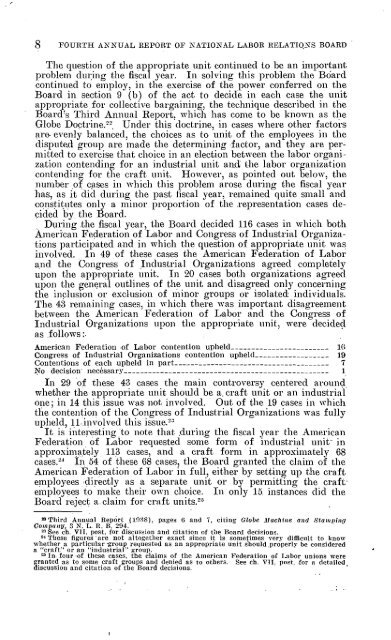J. - National Labor Relations Board
J. - National Labor Relations Board
J. - National Labor Relations Board
- No tags were found...
You also want an ePaper? Increase the reach of your titles
YUMPU automatically turns print PDFs into web optimized ePapers that Google loves.
FOURTH ANNUAL REPORT OF NATIONAL LABOR RELATIONS BOARDThe question of the appropriate unit continued to be an importantproblem during the fiscal year. In solving this problem the BOardcontinued to employ, in the exercise of the ,power conferred on the<strong>Board</strong> in section 9 (b) of the act to decide in each case the unitappropriate for collective bargaining, the technique described in the<strong>Board</strong>'s Third Annual Report, which has come to be known as theGlobe Doctrine. 22. Under this doctrine, in cases where other factorsare evenly balanced, the choices as to unit. of the employees in thedisputed group are made the determining -factor, and they are permittedto exercise that choice in an election between the lab-or organizationcontending for an industrial unit and the labor organizationcontending for the craft unit. However, as pointed out below, thenumber of cases in which this problem arose during the fiscal yearhas, as it did during the past fiscal year, remained quite small andconstitutes only a minor proportion of the .representation cases decidedby. the <strong>Board</strong>.During .the fiscal year'the <strong>Board</strong> decided 116 cases in which bothAmerican Federation of <strong>Labor</strong> and Congress of Industrial Organizationsparticipated and in which the question of appropriate unit wasinvolved. In 49 of these cases the American Federation of <strong>Labor</strong>and the Congress of Industrial Organizations agreed completelyupon the appropriate unit. In 20 cases both organizations agreedupon the general outlines of the unit and disagreed only concerningthe inclusion or exclusion of minor groups or isolated individuals.The 43 remaining cases, in which there was important disagreementbetween the American Federation of <strong>Labor</strong> and the Congress ofIndustrial Organizations upon the appropriate unit, were decidedas follows:.American Federation -of <strong>Labor</strong> contention .upheldCongress of Industrial Organizations contention upheld 19Contentions of each upheld in part 7No decision necessary 1.In 29 of these 43 cases the main controversy centered around.whether the appropriate unit should be a • craft unit or an industrialone; in 14 this issue was not involved. Out. of the 19 cases in whichthe contention of the Congress of Industrial Organizations was fullyupheld, Hip-volved this issue.23It is interesting :to note that. during the fiscal year the AmericanFederation of <strong>Labor</strong> requested some form of industrial unit- inapproximately 113 eases, and a craft form in approximately 68cases. 24 In 54 of these 68 cases, the <strong>Board</strong> granted the claim of theAmerican Federation of <strong>Labor</strong> in .full, either by setting up the craft.employees .,directly as a separate unit or by permitting the craft.employees to make their own choice. In only 15. instances did the<strong>Board</strong> reject a. claim for craft units.2522 Third Annual Report (1938), pages 6 and 7, citing Globe Machine and StampingCompany, 3 N. L. R. B. 294.See ch. VII. post, for discussion and citation of the <strong>Board</strong> decisions.21 These figures are not altogether exact since it is sometimes very difficult to knowwhether a particular group requested as an appropriate unit should properly be considereda "craft" or an "industrial" group.25 In. four ,of these cases, the claims of the American Federation of <strong>Labor</strong> unions weregranted as to some craft groups and denied as to others. See ch. VII. post. for a detailed,discussion and citation of the <strong>Board</strong> decisions.
















